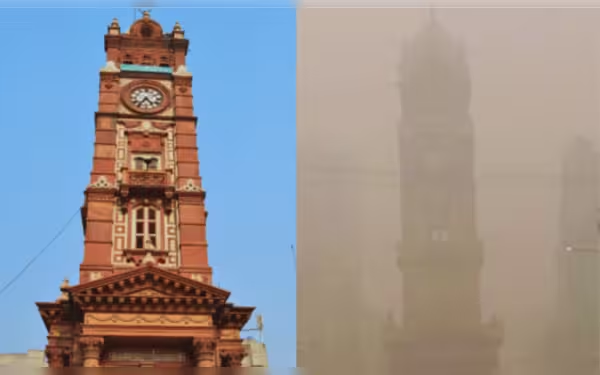Saturday, November 16, 2024 07:47 PM
Lahore Smog Crisis: Health Emergency and Community Response
- Lahore's AQI exceeds 1,200, posing health risks.
- Schools closed as smog worsens in the city.
- Local entrepreneurs innovate air purifiers amid crisis.
 Image Credits: dawn
Image Credits: dawnLahore faces a severe smog crisis, impacting health and prompting community innovation in air purification.
Lahore, the vibrant heart of Pakistan, is currently grappling with a severe environmental crisis as dangerous smog envelops the city. This annual phenomenon has escalated to alarming levels, with air quality indices (AQI) soaring above 1,200 in some neighborhoods. The AQI measures harmful particles in the air, and levels above 300 are classified as "hazardous." This situation has left many residents, particularly those with pre-existing health conditions, in dire straits.
Natasha Sohail, a 29-year-old teacher, has been battling asthma for years. "It’s been horrible; I’ve been sick on and off for the last 10 days," she lamented. Her experience is not unique; hospitals in Lahore are overwhelmed with patients suffering from respiratory and heart diseases. Dr. Ashraf Nizami, president of the Pakistan Medical Association’s Lahore chapter, highlighted the psychological toll this crisis is taking on the community, stating, "The psychological toll the poor air is taking on people remains under the radar."
The Punjab government has acknowledged the gravity of the situation, with senior minister Marriyum Aurangzeb revealing that Lahore experienced 275 days of unhealthy AQI levels over the past year. In response to the deteriorating air quality, authorities have closed all primary and secondary schools, with the possibility of extending this closure if conditions do not improve. Raja Jahangir Anwar, Punjab’s Secretary for Environment, emphasized the need to protect vulnerable populations, particularly young children.
For many families, the financial burden of combating smog is significant. Aliya Khan, a mother of two, has invested heavily in air purifiers, spending a fortune to ensure her children breathe cleaner air. "It cost us a fortune, but that’s not all; the filters must be replaced every year," she explained. The lack of air purifiers in schools adds to the anxiety of parents, who feel compelled to take matters into their own hands.
On the other hand, entrepreneurs like Hassan Zaidi are finding opportunities amid the crisis. Zaidi, a computer engineer, began building air purifiers for his family after his daughter developed a cough. He claims his purifiers are more effective and affordable than imported models, costing just Rs25,000. This innovation reflects a growing awareness and response to the smog crisis among the community.
The government has implemented various measures to tackle the issue, including banning barbecuing without filters and taking legal action against farmers who burn rice stubble. However, some experts argue that these measures are insufficient. Hassan Khan, a farmer, pointed out that agriculture contributes less than 4 percent to smog, suggesting that the focus should shift to larger polluters like the transport industry.
Moreover, the demolition of over 600 smoke-emitting brick kilns has sparked debate. Dr. Parvez Hassan, a senior advocate, criticized the government's approach, advocating for support to kiln owners to transition to cleaner technologies instead. This highlights the complexity of the smog issue, where quick fixes may not address the root causes.
As Lahore continues to battle this environmental crisis, it is clear that a multifaceted approach is necessary. The community, government, and businesses must collaborate to find sustainable solutions that prioritize public health and environmental integrity. The smog crisis serves as a stark reminder of the urgent need for action to protect the air we breathe, ensuring a healthier future for all residents of Lahore.













